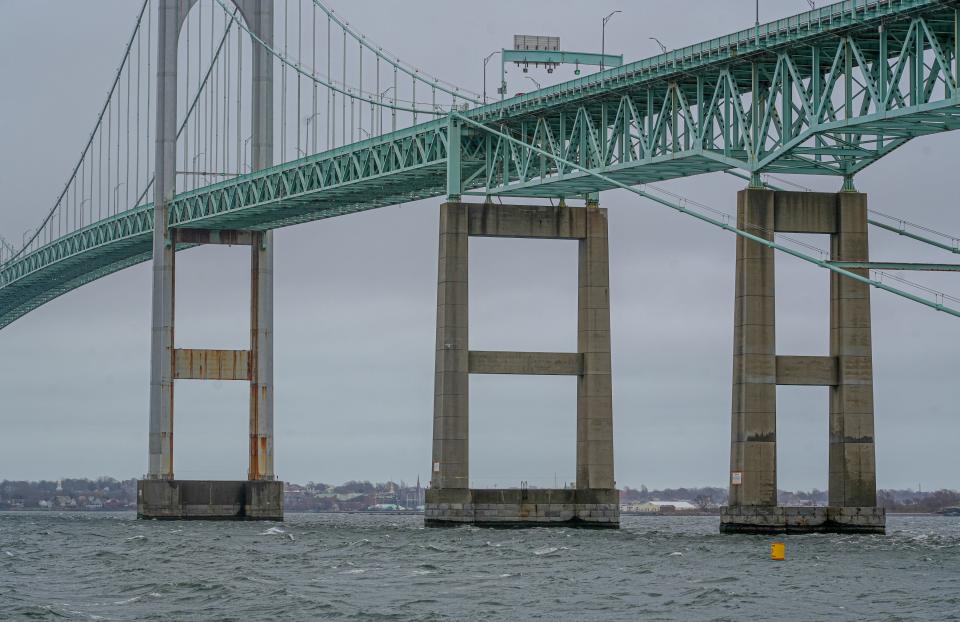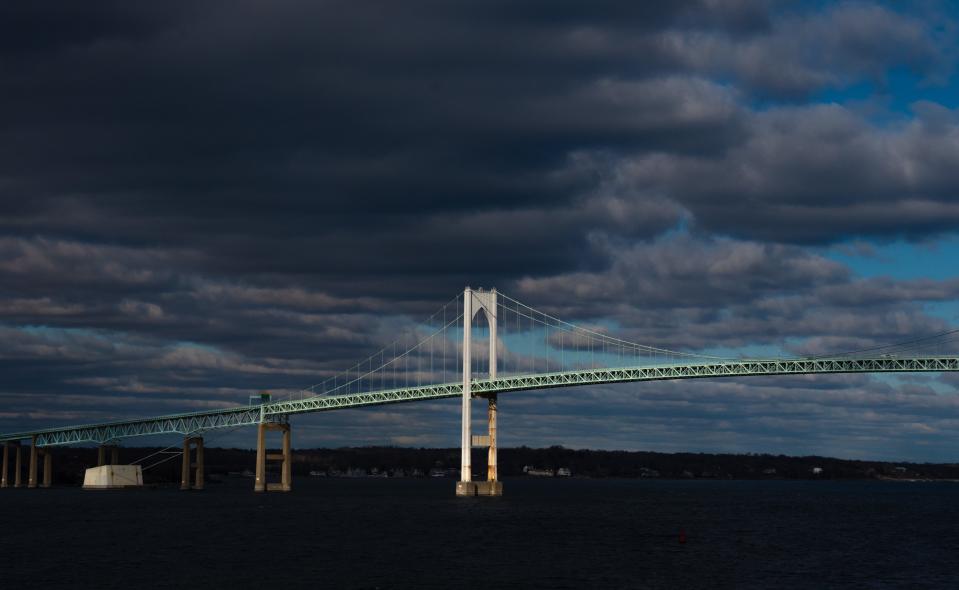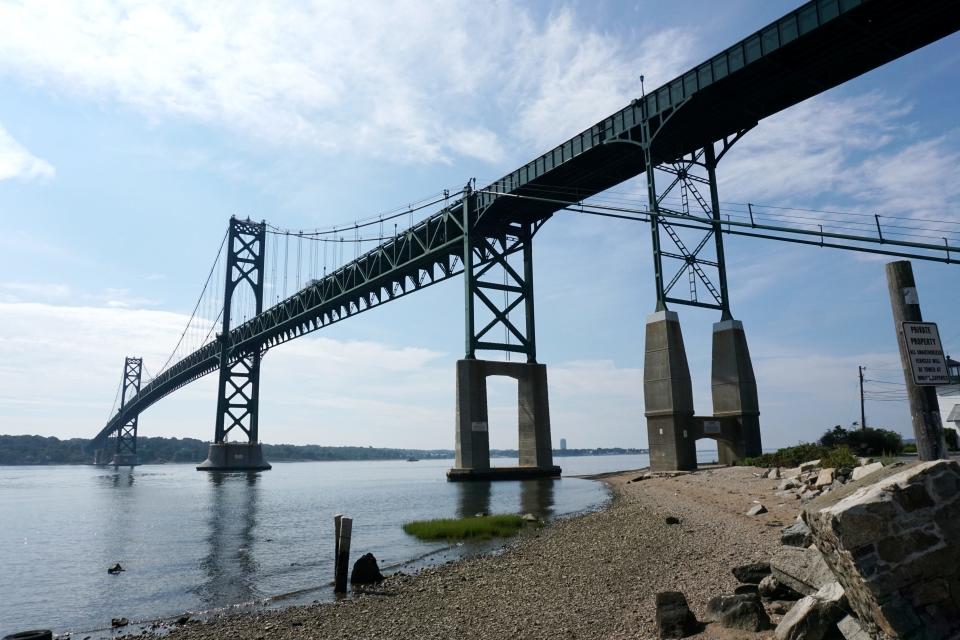Could Baltimore bridge disaster happen in Rhode Island? What to know about the risks.
On a foggy night in 1975, a gasoline tanker plowed into the Mount Hope Bridge.
It was "only by chance" that the gasoline tanks didn't rupture, which "would have probably caused an explosion and fire resulting in the loss of the vessel, the bridge, and possibly human life," the State Pilotage Commission later determined.
In other words, a nightmare scenario like the one that unfolded in Baltimore early Tuesday morning could happen here.
But Rhode Islanders may take some comfort in knowing that the cargo ship that hit Maryland's Francis Scott Key Bridge, causing it to collapse, is larger than the ships that routinely make their way up Narragansett Bay. And that when an oil tanker did hit the Newport Bridge in 1981, it caused no major structural damage.

Ship involved in Baltimore collapse was larger than those unloading at Davisville and ProvPort
The Rhode Island Turnpike and Bridge Authority, which is responsible for the Newport, Jamestown, Mount Hope and Sakonnet River bridges, declined to comment on what would happen in the event of a ship collision. Doing so would be premature, spokeswoman Cara Cromwell suggested when The Providence Journal reached out on Tuesday morning.
As a result, it's hard to know how those bridges compare with the Francis Scott Key Bridge in Baltimore.
But the design and construction of that bridge probably played little role in its collapse, civil engineers told USA TODAY. Once the Singapore-flagged container cargo ship Dali smashed into one of its support columns, the bridge stood little chance.
Federal Highway Administration records indicate that the bridge was in fair condition when it was last inspected in 2021.
It's unclear whether any bridge could have withstood the impact from such a large and heavily loaded vessel. According to Bloomberg, the 948-foot, 32,000-ton ship was carrying about 4,900 containers at the time of accident.
That ship "does not travel in Narragansett Bay and is significantly larger than any ship that sails in the Bay," said David Preston, spokesman for the Quonset Development Corporation.
He noted that the Port of Davisville, one of the country's leading ports for roll-on roll-off car carriers, does not handle container cargo.
ProvPort similarly does not handle container cargo, "nor does any shipping operator in the Port of Providence," said Bill Fischer, spokesman for ProvPort.
The ship involved in the Baltimore incident has never berthed there and is "much larger" than the typical vessel that would do so, he said.

Newport Bridge was hit by heating-oil tanker in 1980s
While the ships entering Narragansett Bay may not be as large as the one that caused the bridge collapse in Baltimore, they're certainly big enough to do some damage – and may be carrying hazardous materials like home heating oil.
"Even if it’s not that the ships are getting bigger, traffic has increased," said Jason McNamee, a Department of Environmental Management official who serves as chairman of the State Pilotage Commission.
Most large ships go under the Newport Pell Bridge, which has considerably more clearance than the other bridges that span the Bay because it was designed to accommodate aircraft carriers. Since that bridge sits in such deep water, it was deemed "impractical" to build free-standing fenders for the bridge as a way to protect it from ships, Thomas R. Kuesel, who directed the preliminary design, wrote in 1983.
Instead, the bridge's pier supports were "designed for an arbitrary ship impact force of 1,650 tons," or roughly equivalent to the force from a 20,000-ton ship traveling at 3 knots, Kuesel said.
That strategy was put to the test on a foggy day in 1981 when a 562-foot oil tanker hit one of the support piers. The collision did only superficial damage to the bridge, and none of the heating oil tanks ruptured, The Journal reported at the time.
In his subsequent analysis, Kuesel calculated that the bridge had withstood a 6,000-ton collision – a much bigger hit than it was designed to handle.
"The Newport Bridge is fortunate that it has good foundations, and that the requirement to design for hurricane winds gives it an extra margin of safety against ship collisions," he noted.
Luck played a major role in the 1975 incident in which a tanker struck the Mount Hope Bridge. That ship "hit the granite and concrete suspension tower in such a way that the stem of its bow, reinforced for ice breaking, absorbed the initial shock and damage," The Journal reported, citing the State Pilotage Commission's report.
What policies does RI have in place to prevent bridge collisions?
McNamee, the commission's chair, said the panel will be reviewing the disastrous incident in Baltimore in order to see if there are any changes that need to be made to prevent a similar scenario here.
But overall, he said, he feels good about the policies that Rhode Island has in place.

State regulations require most large vessels – such as car carriers, oil tankers, other cargo ships and even some cruise ships – to be under the control of a local pilot while underway. Those pilots are "highly skilled and highly trained," McNamee said. (As part of their final test, they have to draw a detailed map of Narragansett Bay, including all its islands and channels, from memory.)
Even newly certified pilots have typically worked on boats for "years and years" before undergoing the equivalent of an apprenticeship and logging enough hours to pilot progressively larger and larger ships, McNamee said.
The ship that hit the bridge in Baltimore was under the control of a local pilot when it lost power. It's still too early to know what went wrong, McNamee said, but the disaster could certainly inspire changes here if it exposes gaps in the system. (Previously, when a container ship became stuck in the Suez Canal, that led to stricter rules on the use of cellphones.)
"Whatever happened there could conceivably happen in Rhode Island as well," McNamee said. "But we try to be proactive."
This article originally appeared on The Providence Journal: Could a large ship cause a Baltimore-like bridge collapse in RI?

